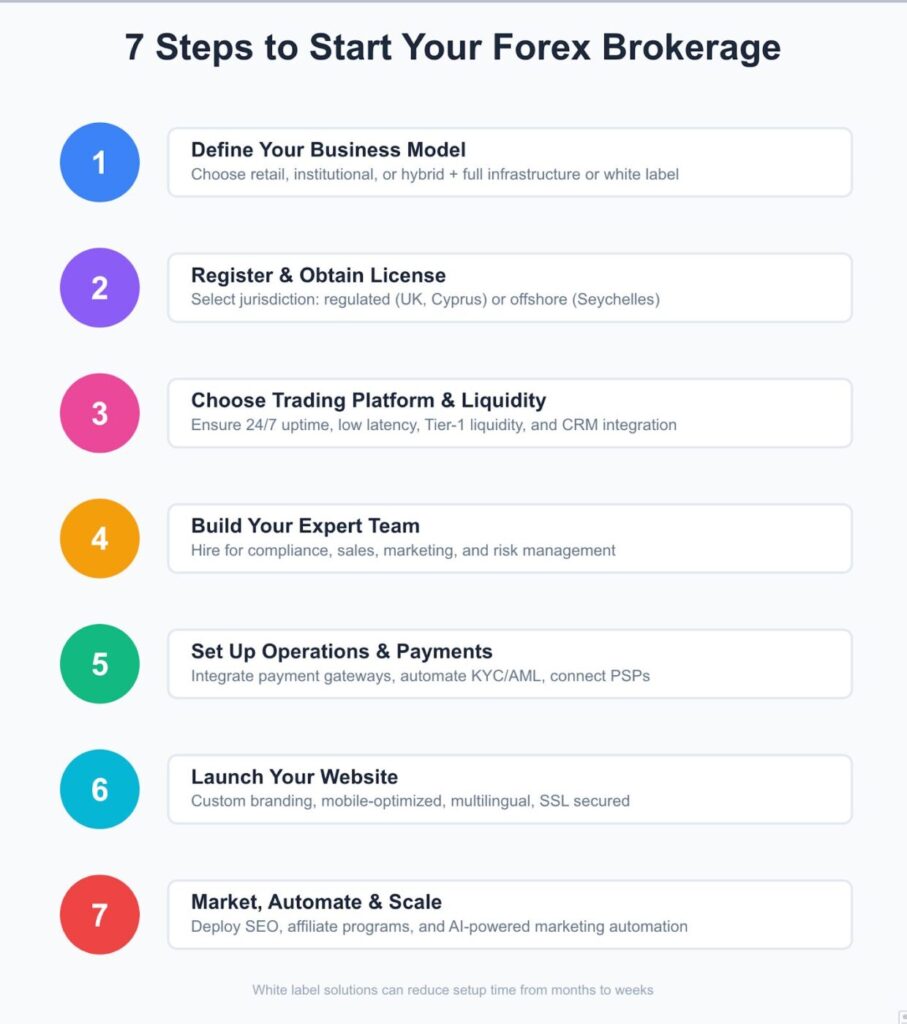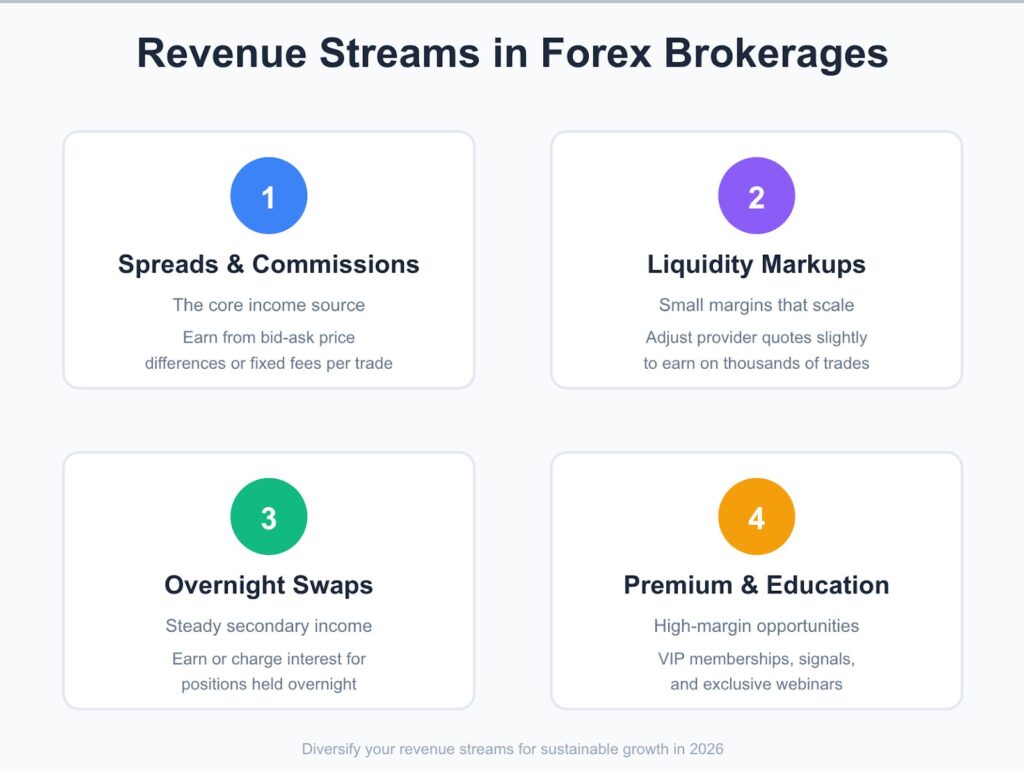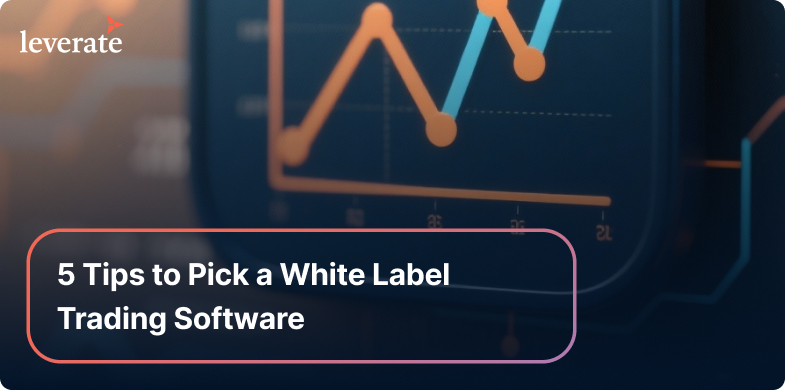
How to Start a Forex Business in 2026
If you’ve ever wondered how to start a forex business, you’re tapping into one of the most scalable opportunities in modern fintech. The foreign exchange (forex) market is the world’s largest financial ecosystem, with over $7.5 trillion traded daily. As trading technology evolves and retail participation skyrockets, launching your own brokerage in 2026 is no longer reserved for the elite few; it’s now open to visionaries ready to blend tech, marketing, and risk management into a sustainable enterprise.
In this guide, you’ll learn exactly how to start your own forex brokerage, from choosing the right model to building a reliable team, securing licensing, and generating steady revenue streams. Whether you aim to start a forex trading company from scratch or leverage a white label platform, this blueprint walks you through each step with actionable insights.
Steps to Starting Your Own Forex Brokerage
Before you build your trading empire, you need a foundation that blends business logic, technology, and compliance. Here’s a complete step-by-step breakdown of how to start a forex trading company in 2026.
1. Define Your Business Vision and Model
Every successful forex brokerage starts with clarity of purpose. Decide what kind of experience you want to offer: retail, institutional, or hybrid.
You’ll also need to choose your operational model:
- Full Infrastructure Model: Build your own trading platform, liquidity network, and risk engine. It’s costly but offers total independence.
- White Label Solution: Partner with an established fintech provider like Leverate to get instant access to trading platforms, liquidity, CRM, and compliance tools. This is the fastest, most cost-effective path if you want to start a forex brokerage firm without reinventing the wheel.
White label setups let you go live in weeks instead of months. Deloitte reports that outsourcing technology and infrastructure can reduce operational costs by up to 70%. In 2026, this model dominates new broker launches due to its scalability and compliance readiness.
2. Register and License Your Brokerage
Once your business plan is clear, it’s time to make it official. You’ll need to register your company and obtain a forex license in a suitable jurisdiction.
Your options include:
- Regulated jurisdictions (like Cyprus, the UK, or Australia): higher trust, but stricter, costlier compliance.
- Offshore jurisdictions (like Seychelles, Mauritius, or the Cayman Islands): faster setup and lower fees, ideal for startups testing new markets.
Licensing ensures you can open corporate bank accounts, form PSP (payment service provider) agreements, and protect client funds. Regulations are tightening globally, so staying ahead on compliance is key to survival.
3. Choose a Trading Platform and Liquidity Provider
Your trading platform is the lifeline of your brokerage. It’s where traders interact, execute, and trust your brand. When deciding how to start a forex business, prioritize:
- Platform Stability: 24/7 uptime, low-latency execution, and intuitive UX.
- Liquidity Depth: Direct connections to Tier-1 banks and liquidity providers.
- CRM Integration: To monitor trader behavior, manage leads, and automate marketing.
Leverate’s turnkey white label package includes everything from liquidity and trading servers to branded client portals and multilingual CRMs, helping brokers launch with institutional-grade tech from day one.
4. Build a Skilled Team
Technology attracts clients, but people retain them.
To start your own forex brokerage, assemble a team of experts in:
- Compliance & Legal: To ensure all processes meet licensing standards.
- Sales & Retention: To grow your client base and build long-term relationships.
- Marketing & Automation: To create lead funnels that scale.
- Risk Management: To monitor exposure and protect against trading volatility.
Invest in training. Your sales and support teams must understand both the technology and psychology of traders.
5. Set Up Operations and Payments
Operational flow is where many new brokerages stumble. A well-structured backend keeps everything running smoothly:
- Integrate payment gateways that support multiple currencies and instant deposits/withdrawals.
- Automate KYC (Know Your Customer) and AML (Anti-Money Laundering) checks for onboarding.
- Establish relationships with liquidity and PSP partners.
Modern brokerages run on event-driven systems, one deposit triggers an onboarding message, one rule violation triggers an automated warning, and one milestone triggers a loyalty reward. Platforms like Leverate’s Prop Suite already integrate these real-time workflows seamlessly.
6. Build and Launch Your Brokerage Website
A strong online presence is non-negotiable. Your website is your first impression, your storefront, marketing hub, and credibility signal.
Rather than spending months coding and designing, opt for a white label provider who offers:
- Custom branding and domain setup
- Mobile-optimized client areas
- Multilingual support
- Secure SSL and compliance certifications
Leverate’s web solutions allow brokers to go live in weeks, with proven UX frameworks that maximize conversions and retention.
7. Market, Automate, and Scale
You cannot grow what you cannot measure. Smart brokerages combine digital marketing with AI driven analytics to turn leads into lifetime traders.
To start a forex brokerage firm that thrives, invest in:
- SEO and content marketing: Build authority around keywords like forex trading strategies, leverage, and market analysis.
- Affiliate and IB programs: Reward partnerships that bring consistent traders.
- AMS (Automated Marketing Systems): Use data-driven segmentation to deliver the right message at the right time.
Leverate’s AI-Powered AMS suite lets you create automated journeys, from first deposit to retention, turning one-time clients into loyal trading customers.

Business Model for Forex Trading Company
Your business model defines how you earn, scale, and sustain profits. Understanding this structure early prevents costly mistakes later.
A-Book (Agency Model)
Trades are passed directly to liquidity providers. You earn via spreads or commissions, maintaining transparency and alignment with clients. Ideal for brokerages that prioritize trust and long-term relationships.
B-Book (Dealing Desk Model)
Your firm acts as the counterparty to client trades. It’s more profitable but riskier; success depends on having an intelligent risk engine and strong analytics.
Hybrid Model
The best of both worlds. You can route consistent traders to the B-Book and volatile ones to the A-Book, optimizing profits while controlling risk exposure. Most 2026 brokerages operate on hybrid systems, using machine learning to analyze trade behavior in real time.
Revenue Streams in Forex Brokerages
When mapping how to start a forex business, revenue diversification is crucial. A well-designed brokerage earns from multiple streams, not just trades.
Here are the top revenue channels in 2026:
1. Spreads and Commissions
The bread and butter of brokerages. The difference between bid and ask prices — or a fixed commission per trade, forms the base of your income.
2. Liquidity Markups
By slightly adjusting liquidity provider quotes, brokers earn small margins that scale significantly across thousands of trades.
3. Overnight Swaps
You can earn or charge interest for holding positions overnight. This is a secondary but steady income line.
4. Premium Accounts and Education
Offer paid VIP memberships, trading signals, and educational webinars. Many traders are willing to pay for exclusive insights, creating high-margin opportunities.

Challenges and Opportunities in 2026
The global landscape is evolving fast. Regulation is tightening, traders are getting smarter, and competition is fierce. But opportunity lies in innovation:
- AI-based trading insights are transforming broker analytics.
- Blockchain payments are improving transaction speed and transparency.
- Multi-asset exposure (FX, crypto, stocks, commodities) is attracting wider audiences.
To start your own forex brokerage that lasts, focus on transparency, automation, and adaptability. The firms that integrate compliance with creativity will dominate the next wave of trading.
Conclusion
Learning how to start a forex business is about more than just setting up a platform, it’s about building a resilient, technology-driven company that evolves with the market.
With the right partner, you can skip the trial-and-error phase and focus on what matters most: client growth, risk control, and brand trust. Leverate’s white label and AMS solutions empower brokers to operate efficiently, scale globally, and remain compliant every step of the way.
So, if you’re ready to start a forex trading company, then 2026 is your year to make it happen. With the right systems and support, your brokerage can rise from concept to global player faster than ever before.
How To Start A Forex Brokerage: FAQs
How do I start a Forex brokerage?
To open your own Forex brokerage, you’ll need to:
- Choose a platform provider
- Register your company
- Open your call center
- Hire and train your team
- Drive traffic to your brokerage
Opt for a white label solution with Leverate, the leading technology provider that helps you launch efficiently and scale confidently.
How much does it cost to start a forex brokerage firm?
Setup costs vary depending on your model and jurisdiction. With a white label package, you can drastically cut expenses while maintaining full branding control. Leverate offers competitive pricing tailored to different brokerage sizes.
How much money do Forex brokers make?
Profits depend on scale, spreads, and client activity. Leading brokerages that integrate AI-powered AMS tools and automation tend to see higher retention and revenue per client.
How do I set up a Forex brokerage website?
Modern white label providers like Leverate handle everything: design, hosting, integrations, and security. Leverate’s web packages let you launch a fully branded brokerage site with optimized UX, compliance-ready infrastructure, and multilingual capabilities.
How do I get a Forex brokerage license?
To register your brokerage, open a bank account, meet jurisdictional capital requirements, and comply with AML/KYC laws. To better understand the compliance procedures for registering your Forex company, consult Leverate for professional guidance.



